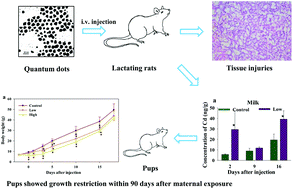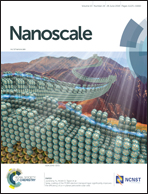Quantum dots cause acute systemic toxicity in lactating rats and growth restriction of offspring†
Abstract
The in vivo toxicity of QDs in animals has been broadly studied; however, their reproductive toxicity towards lactating rodents is currently unknown. This study therefore aims to assess the potential toxicity against dams and offspring after postnatal QD exposure at two doses (5 and 1 nmol per rat) and unravel whether QDs can translocate to pups via breastfeeding. The dose-dependent systemic toxicity of QDs in dams was observed by examining the body weight, hematology, biochemistry, histopathological changes, and sex hormone levels. It was found that the QDs primarily accumulated in the liver and spleen of dams at 1 day post injection (dpi), but the highest concentrations were found in the kidneys at 18 dpi. A few QDs were detected in breast milk and stomach and intestine of pups; this suggested that the QDs were transmitted to breast milk via blood circulation and then transferred to pups via breastfeeding. High-dose QDs induced severe growth inhibition and a 71.08% offspring mortality, while pups showed growth restriction within 90 dpi in the low-dose group. Moreover, the hematology, biochemistry, and histology results showed limited chronic toxicity against offspring in the long term. This study provides a theoretical foundation for the exposure assessment of nanomaterials in lactating animals and for the advancement of QDs in the biomedical field.



 Please wait while we load your content...
Please wait while we load your content...